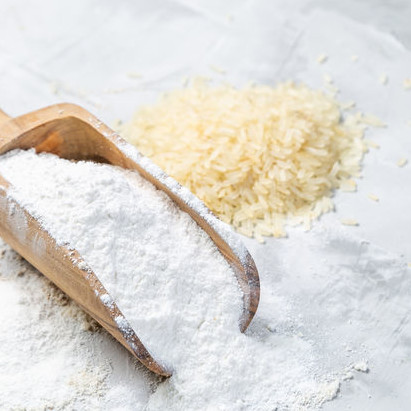White Rice Flour
What is White Rice Flour?
White rice flour is a gluten-free flour made from the milling of polished white rice. It has a characteristic white color, neutral flavor and fine texture due to the elimination of bran and germ during milling. It’s often used as a sauce thickener and as substitute for wheat flour in baking.1
White rice flour varieties may differ in functional properties due to the:1
- Rice variety
- Milling process
- Amylose content (waxy or non-waxy)
Origin
Rice (Oryza sativa) is one of the most commonly consumed cereal crops in the world. Rice flour originated in asian cuisine, mainly for making rice cakes and noodles. It was introduced to the Western world in the 1980s, where it rapidly became a staple ingredient for gluten-free baked goods.1 Asia is responsible for over 90% of the world production of rice.1
Function
In baked goods, white rice flour serves several functions:1,2
- Provide structure: due to interactions between white rice flour starch and gluten in wheat flour.
- Liquid absorption: a result of the flour’s high water absorption.
- Flavor: provides a characteristic mild neutral taste.
- Color: sugars in the flour can undergo Maillard browning reaction.
- Nutritional value: mainly its contribution to gluten-free preparations.
Nutrition
Typical nutritional value per 100 g:1
| Component | Grams |
| Carbohydrate | 80.1 |
| Moisture | 9.6 |
| Protein | 5.9 |
| Dietary fiber | 2.4 |
| Lipids | 1.4 |
| Minerals | 0.6 |
This type of flour provides 359 kcal per 100 g and can be safely consumed by people with celiac disease. It has a slightly lower glycemic index (72) than white wheat flour (85), i.e. a medium-high glycemic index.
Commercial production
This flour is commercially produced through the following process:1
- Cleaning: paddy rice is passed through coarse screens to remove stones, straws and other impurities.
- Metal removal: magnets are used to remove metallic impurities.
- Husk removal: spinning rubber rollers are used to remove the husk.
- Removal of bran and germ: using abrasive whitener systems over 95 of the bran is removed in the first stage. Subsequently, the rest is removed using friction whiteners.
White rice flour for baked goods can be obtained through two grinding methods:1
Wet grinding:
- Soaking: rice kernels are soaked in water to soften.
- Grinding: wet kernels are ground.
- Drying: excess moisture is removed by drying followed by grinding.
Semi-dry grinding:
- Soaking: rice kernels are soaked in water to soften.
- Drying: excess moisture is removed by drying.
- Grinding: dried kernels are ground followed by grinding.
Application
White rice flour adds creaminess and crunchiness to baked goods. Although it is not suitable for baking on its own, blending with wheat restores its structure building ability. In gluten-free baking hydrocolloids are used instead.1,3
Commonly used structure building aids:1
- Gluten can be used in low proportions (<20%) to aid in structure building.
- Carboxymethylcellulose (CMC) can be used up to 2% in bread to provide good volume and consumer acceptability.
- Hydroxyethylcellulose (HPMC) used up to 4% to provide optimum dough rheology and loaf structure as well as volume increase.
- Corn flour, tapioca flour and other gluten – free flours can be used as the structure building aid.
Typical properties of baked goods made with white rice flour:1,3
| Product | Use | Effect |
| Bread | Wheat flour substitution |
|
| Cookies | Wheat flour substitution |
|
| Frozen biscuits and pizza | Separating powder |
|
| Deep fried batters | Batter thickener |
|
| Puddings | Thickener |
|
Regulations
White rice flour is considered safe by the FDA when produced following good manufacturing practices.4
In the EU, white rice flour is considered safe, and quality parameters for rice varieties used in food manufacture are regulated by the EU Commission No1423/76.5
References
- Arendt, E and Dal Bello, F. Gluten-free cereal products and beverages. Elsevier, 2011.
- Figoni, P. How Baking Works: Exploring The Fundamentals Of Baking Science. 2nd ed., John Wiley & Sons, Inc., 2008.
- Hui, Y. H., Corke, H., DeLeyn, I., Nip, W-K and Cross,N. Bakery products: science and technology. 1 st ed., John Wiley & Sons, 2006.
- Food and Drug Administration (FDA). US Department of Health and Human Services. CFR Code of Federal Regulations Title 21, Part 137 Cereal Flours and Related Products, https://www.accessdata.fda.gov/scripts/cdrh/cfdocs/cfcfr/CFRSearch.cfm?fr=137.350 , Accessed 12 November 2020.
- European Commission (EC). Council Regulation (EEC) No 1423/76 of 21 June 1976 determining standard qualities for rice and broken rice. Official Journal of European Communities, 17 December 2013.


